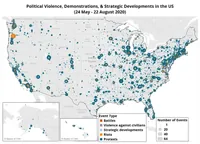Massive California Wildfire Creates Own Weather as Firefighters Battle Heat
A large wildfire in Southern California has forced thousands to evacuate and created its own weather systems. Firefighters hope cooler temperatures will aid containment efforts in the coming days.

In Southern California, a significant wildfire known as the Line Fire has been raging since Thursday, September 5, 2024, forcing the evacuation of at least 6,000 people and threatening numerous structures. The blaze, located approximately 105 kilometers east of Los Angeles, has created challenging conditions for firefighters due to extreme heat and difficult terrain.
Rick Carhart, a spokesperson for Cal Fire, explained the unique challenges faced by firefighters: "We're confronting temperatures exceeding 37.7 Celsius and hard-to-access steep areas where fires have not occurred in decades or recorded history. This has resulted in substantial fuel loads." Cal Fire, responsible for protecting over 31 million acres of California's privately-owned wildlands, has been at the forefront of this firefighting effort.
The Line Fire has burned approximately 96 square kilometers of vegetation and is only 5% contained. The intense heat generated by the fire has led to the formation of pyrocumulonimbus clouds, fire-induced thunderstorms that can create hazardous weather conditions such as gusty winds and lightning strikes.

The wildfire's location in the San Bernardino National Forest, which covers 823,816 acres of diverse terrain, has complicated firefighting efforts. This area includes popular destinations like Running Springs and Big Bear, known for winter skiing and summer mountain biking.
"That's about all I can do, aside from standing on the top of the roof with my garden hose, but that's not in the plans."
Residents of affected areas, including the unincorporated community of Mountain Home Village, are facing difficult decisions about whether to evacuate or stay to protect their properties. The wildland-urban interface, where human development meets wildland areas, poses unique challenges for fire management in such situations.
The Line Fire is one of several wildfires currently burning across the Western United States. Other significant fires include:
- A blaze in Orange County, California
- The Boyles Fire in Clearlake City, north of San Francisco
- The Davis Fire near Reno, Nevada
- Multiple fires in Idaho and Oregon, including one near Mount Bachelor in the Deschutes National Forest
Climate change has been linked to an increase in the frequency and intensity of wildfires in the Western United States, making fire ecology an increasingly important field of study. Some ecosystems depend on natural fire cycles for regeneration, but the current intensity and frequency of fires pose significant challenges.
Firefighters and residents are hopeful that the expected cooler temperatures after Tuesday, September 10, 2024, will aid in containment efforts. The National Interagency Fire Center continues to coordinate wildland firefighting resources across the affected states as they battle these numerous blazes.


































